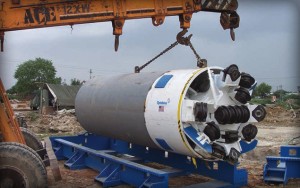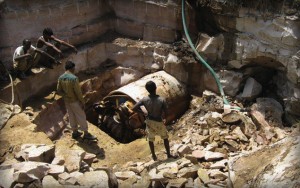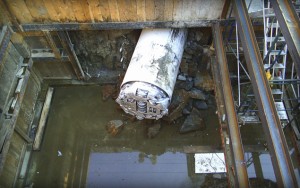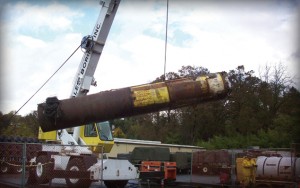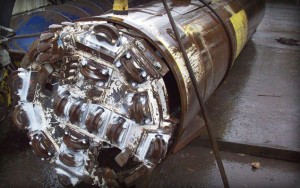Project Categories: 小型掘进设备
科塔城市供水项目
项目概况
持续了8年之久,在经历了多次失败尝试之后,位于印度拉贾斯坦邦科塔市的一条重要供水线上只剩下三个硬岩交叉地段尚未贯通。之前的承包商试图采用人力开采和水平定向钻井法(HDD)挖通位于坚硬的石英岩里的交叉地段,但后来由于产能低下而被迫放弃。仅4.5米(15英尺)宽乘11米(36英尺)的始发井就用了4个月,每天的速度是200-300毫米(8-12英寸)。2008年,承包商Vichitra建筑私人有限公司签订合同,负责完成贯通长50米(164英尺)的交叉地段。
长13公里(8英里)的管线是印度拉贾斯坦邦城市基础设施发展规划(RUIDP)的一部分,用于增加城市供水和解决水污染问题。系统建成后每天为约7万人提供2400万升(630万加仑)的水。
在研究了不同的技术之后,Vichitra购买了一台直径1.5米、刀盘直径11.5英寸的罗宾斯小型隧道掘进机 (SBU-A)和一台罗宾斯60-1270螺旋掘进机(ABM)。这项技术由罗宾斯隧道和非开挖技术(印度)私人有限公司提供,这是一家位于新德里的当地子公司,该公司还向承包商提供技术支持、机组人员和刀具改造服务。
地质状况
大部分的交叉地段由石英岩(无侧限抗压强度为200-150 MPa/2,9000-3,6000psi)组成,附有一些土壤和淤泥地带。
小型掘进机(SBU-A)
小型隧道掘进机,直径24-72英寸不等,通常用于长度达500英尺的交叉地段,使用一台标准的螺旋掘进机(ABM)和钢制套筒。挖掘过程中,小型隧道掘进机焊接在主套装上,螺旋钻孔机为刀头提供扭矩和正向推力。圆形刀盘配有单刃盘形滚刀用于挖凿硬岩,或配备一个由单刃盘形滚刀、双排内嵌式硬质合金刀具和硬质合金钻头的组合来挖凿混合地质。盘形滚刀钻穿岩石表面,制造出“破碎带”,裂纹由此传播。相邻破碎带之间的物质从表面掉落,渣土输送机将泥渣收集到到刀盘的开口上,然后,通过一台全断面螺旋钻运走。
交叉掘进
2008年秋季,三条轨道在耐磨的硬岩中完成贯通。在一条铁道下面的交叉地段掘进机从轨道两旁贯通了两段长50米(164英尺)的通道。第一条通道,每小时进尺1.5米(5英尺),穿过交叉地方进入两组轨道之间的中心竖井。在经历了硬岩中进行明挖作业的困难之后,在巷道下方增加了第三段长14米(46英尺)的隧道挖掘。
米尔福德港天然气连接项目
驱动式小型掘进机强劲穿透英国管道线上的挡路石
项目概况
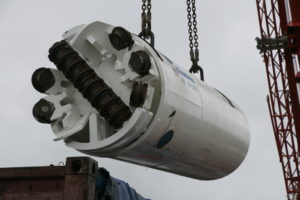
作为英国最全面的基础设施开发项目之一,米尔福德港天然气连接项目横跨南威尔士,延伸超过300公里(90英里)。该项目管道从米尔福德港的一个港口运送液化天然气(LNG),为项目业主国家电网提供高达20%的英国天然气。
项目由两个阶段组成,管道施工于2006年初开始。两个阶段均于2007年11月完工,第一阶段从米尔福德港城镇延伸到Aberdulais,长达120公里(75英里),第二阶段从Felindre到格洛斯特郡的Tirley,将管道又延长了185公里(115英里)。
总承包商NACAP /Land & Marine公司建造许多阶段I和II的交叉地段,将一些硬岩交叉地段分包给了当地承包商B&W隧道建设有限公司(B&W)。B&W使用了三台直径1.2米(48英尺)的罗宾斯As小型隧道掘进机和两台直径1.2米(48英寸)的罗宾斯Ms小型隧道掘进机挖掘63个长度在20-80米(65-260英寸)之间的交叉地段。
地质概况
大多数的交叉地段都位于带有一些粘土和砾石粉砂岩和泥岩 (无侧限抗压强度为70-200 MPa/10,000-29000psi)之中,附有一些粘土和碎石夹层。
驱动式小型掘进机
由于项目线路具有挑战性,并且其负责的四个最长挖掘地段有坡度限制,B&W公司选择了驱动式小型隧道掘进机(SBU-M)。公差仅50毫米(2英寸)意味着B&W需要一台精度提高且能持续监控的掘进机。
驱动式小型隧道掘进机是一种载人进入式硬岩隧道掘进机,适用于用于较长距离挖掘(长度超过150米/500英尺)和对线路&坡度挑剔的交叉地段。该掘进机与一台标准的螺旋掘进机(ABM)或顶管装置协同使用,以与As小型隧道掘进机相同的方式焊接到主套管。位于后护盾中的操作员使用控制台持续操纵掘进机,激光瞄准系统用来监孔掘进机的掘进方向
B&W使用了两台机动化小型隧道掘进机,一台用于硬岩石,另一台用于混合地质。用于混合地质的掘进机的刀具配有直径9.5英寸单刃盘形滚刀和更大开口的出渣铲斗,以处理带有粘土和碎石夹层的岩石地段。
隧道掘进
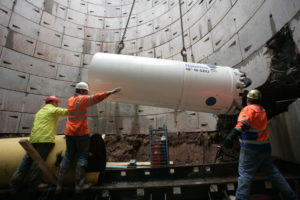
所有的交叉地段都得以成功贯通,一般平均每小时进尺1.5-2.0米(5-6.5英尺)。每一个由小型隧道掘进机贯通的交叉地段都使用了直径1.2米(48英寸)的螺旋钻孔机,并且需要一个24米(80英尺)长乘 3米(10英尺)宽的浅始发井。令人难以置信的是,三台小型隧道掘进机完成了53个长30米(100英尺)的交叉地段(共掘进约1600米/5300英尺),全程仅更换了一个刀具
每一个驱动式小型隧道掘进机贯通的交叉地段都要求使用10-30米(33到100英尺)深的始发井和接收井。直径10.5米(35英尺)竖井是用混凝土锚杆固定的管片圈梁衬砌起来的,在交叉地段贯通后用于安装管道。牺牲阳极套管(钢制,外径1.2米/48英寸)为削割面提供来自螺旋钻孔机的必要的正向推力。管道随后被移走,最后的管线由一台半自动电焊机安装。
切斯特大道截流下水道项目
小型硬岩掘进机刀头迅速完成印第安纳下水交叉隧道
项目概况
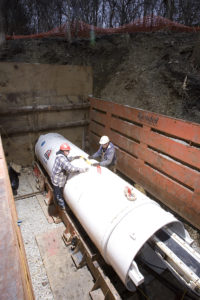
印第安纳州的里士满市是一个拥有5万人口且在不断发展中的城市。为了满足未来的发展规划,该市制定了一项计划,通过6.4公里(4英里)长的扩建项目将目前下水道系统的容量增加一倍。届时,新的重力下水道也将取消对昂贵的泵站的需求。
2006年12月,里士满市卫生区和总承包商布拉克尼公司(Brackney, Inc)签订了一份价值470万美元的合同,建造切斯特大切斯特大道截流下水道。该下水道在新管道基础上延伸3.2公里(2英里),为一个商业区和附近的医院提供排污服务。随后,布拉克尼公司将河流和步行古道下方4处交叉隧道的硬岩挖掘工作分包给了中西部摩尔公司(Midwest Mole, Inc.)。中西部摩尔公司选择了直径1.2米(48英寸)的小型掘进机用于挖掘最短的2处隧道(长度为55米/180英尺),以及直径1.4米(54英寸)的单护盾小型硬岩掘进机用于挖掘2段最长的隧道(每段长度为120米/400英尺)。
地质状况
交叉隧道位于页岩和石灰岩之间,岩石的单轴抗压强度高达70兆帕(10200千磅力/平方英寸)。所有交叉隧道区都是硬质地质,几乎不会出现涌水。
硬岩掘进刀头
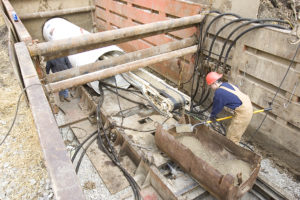
对于单轴抗压强度从20兆帕至超过175兆帕(4000至25000千磅力/平方英寸),且位于地下水位以上的硬岩或混合地质条件,小型硬岩掘进机是最行之有效的技术设备。基于交叉隧道的长度和严格的线路和坡度要求,中西部摩尔公司决定使用罗宾斯公司的岩头式隧道掘进机来进行最长交叉隧道的挖掘工作。交叉隧道区域要求挖掘坡度精度为0.25%,这对岩头式隧道掘进机来说轻而易举。位于掘进机后盾中的操作员可以通过控制台让机器连续不断地工作。
为了优化破岩效果,直径1.4米(54英寸)的掘进机的刀盘上配备了获得专利的直径6.5英寸的单刃盘形滚刀。这台掘进机属中西部摩尔公司所有,曾参与过自2005年以来的六个前期项目。在挖掘超过1200米(3900英尺)后,掘进机被送到了罗宾斯公司的车间进行了首次翻新和刀具更换。此时,重力下水道交叉隧道部分还没有开工。
隧道开挖
2007年3月,中西部摩尔公司打通了第一个长120米(400英尺) 的交叉隧道。小型硬岩掘进机被焊接在直径140米(54英尺)的主钢制套筒上,通过管顶系统从探井中启动。掘进机平均每10小时/班内掘进6-8米(20-26英寸),按规定时间和坡度要求完成贯通。第二个交叉隧道在2007年5月开挖,掘进机取得了高达9米(30英尺)每班次的更高掘进速度。
两台小型掘进机完成交叉隧道的结果近乎一致。每一个55米(180英尺)的交叉隧道,坡度要求0.42%,都需要对掘进机的航向进行连续的监控。稳定座位于掘进机机身的每四分之一处,用来稳定机身,让掘进机在前6-8米(20-26英尺)的前进过程中进行转向。机组人员借助液压缸改变稳定座的高度,从而调整掘进机的航向。在掘进机打通前6-8米(20-26英尺)之后,检查校准需要使用荷兰式水准仪。如果调整的方向漂移了,螺旋钻会被拉回并复位到正确航向上。这台掘进机在两个交叉隧道速度每10小时/班内的平均掘进都达到了6米(20英尺)。
格伦伍德电缆项目
项目概况
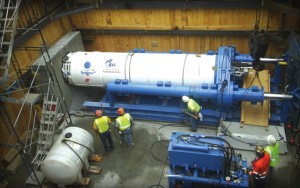 EIC组织于2006年签约,在美国康涅狄格州的斯坦福德(Stamford)、达利恩(Darien)和诺瓦克(Norwalk)建造超过13公里(8英里)的115千伏输电线路。最后的系统包括由92条供电库和62个电线杆组成的3相电路。EIC使用了一台罗宾斯直径1.50米(60英寸)的双护盾小型硬岩掘进刀机(SBU-RHDS),在达利恩的地铁北铁路下挖出两个十字路口,结果发现这是条特别困难的岩石隧
EIC组织于2006年签约,在美国康涅狄格州的斯坦福德(Stamford)、达利恩(Darien)和诺瓦克(Norwalk)建造超过13公里(8英里)的115千伏输电线路。最后的系统包括由92条供电库和62个电线杆组成的3相电路。EIC使用了一台罗宾斯直径1.50米(60英寸)的双护盾小型硬岩掘进刀机(SBU-RHDS),在达利恩的地铁北铁路下挖出两个十字路口,结果发现这是条特别困难的岩石隧
由于非常糟糕的地质条件,Hayward-Baker, Inc的子公司G.Donaldson,为项目座了两种预灌浆。采用的两种灌浆方式是:水平灌浆以稳定隧道的对齐方式,以及在公路和铁路结构周围的垂直灌浆,以降低表面沉降的风险。
地质概
开挖区域的探索性测试发现,高度断裂的元石英陨石,从单轴抗压强度达5000到20000 psi(35到140 兆帕),岩石质量平均为45%。由于不稳定的地质条件,隧道的位置又降低了3米(9英尺)。然而,进一步的测试发现这里也有大量的断裂带。
小型硬岩掘进机
小型硬岩掘进机最适合长时间隧道,在那里,线性和坡度是关键,比如重力下水道。由于岩石的不稳定性和掘进的长度,EIC选择了最好的选择,罗宾斯双护盾小型硬岩掘进机。
直径为150米(60英寸)的双护盾小型硬岩掘进机,专门为高度断裂的岩石设计,突出的是一个排扣板,在标准的刀盘前面有一个钢板,有一个单排滚刀的槽口。此外,在污泥中还增加了排栏板,以限制输送带上的岩石大小。
隧道掘进
挖掘工作始于2008年春季,每周工作6天,每周工作2个小时。由于岩石硬度,这台机器每小时平均有254到635毫米(10到25英寸)的速度。使用铰接油缸和稳定垫,该机器能够在整个掘进中保持线性和坡度。EIC选择用钢筋混凝土管来衬砌衬管,这是用顶管系统在机器后面铺设的。
在整个掘进过程中,现场服务技术人员调整了机器的穿透率,如预先灌浆的部分使岩石面更软,更容易挖掘。这种调整既需要减少推力缸压力,也需要减少刀盘速度,以避免用过多的碎片堵塞清除污物的系统。这台机器的变速电机可以在整个驱动过程中进行微调。
洛克斯特街6335号卫生改善项目
项目概况
在俄勒冈州的泰格德市,西北推土机公司(Northwest Earthmovers Inc.)作为总承包商为项目业主清洁水服务公司(Clean Water Services),建造了长度超过1.8公里(1.1英里) 的重力下水道。冈萨雷斯掘进和隧道挖掘公司(Gonzales Boring & Tunneling)作为分包商,负责完成三个交叉隧道的挖掘工作,这也是第6335号洛克斯特街道卫生改善项目的一部分。三个交叉隧道的测量长度分别是70米 (230英尺),183米(600英尺)和98米(320英尺)。隧道内安置着直径450毫米(18英寸)的PVC输送管,用来增加该地区的污水容量,终结目前一直困扰排污系统的溢水问题。
冈萨雷斯掘进和隧道挖掘公司购买的是一台直径为1米(42英寸)的罗宾斯A型小型掘进机,用于完成位于房屋、相邻街道、一条小溪和一个服务设施下方的3处交叉隧道。
地质状况
第一个交叉隧道的岩石构造由黏土和玄武岩构成,第二个交叉隧道则由强度从48到82兆帕(7000到12000 磅/平方英寸)不等的玄武岩构成。交叉隧道区域还散布着带有污垢的小巨石。
小型掘进机特色
罗宾斯小型掘进机可以根据地质条件,配置多种硬质合金钻头和单排或多排的盘形滚刀。为冈萨雷斯钻孔公司准备的小型掘进机的刀具配备了直径为165毫米(6.5英寸)的单刃刀盘和更大开口的淤泥铲斗,用于处理复杂的地质环境。
在掘进机启动过程中,A型小型掘进机被焊接在主钢制套筒上,刀盘在螺旋钻探机产生的扭矩和推力的驱动下前进。弃土通过刀盘里的开口,又叫淤泥铲斗,搬离再由全断面螺旋钻排出。
隧道掘进机
工人们对线路和坡度进行了监控,并且能够在每10小时轮班内维持12米(40英尺)的掘进速度。通过使用一个由承包商设计的转向系统,A型小型掘进机掘进了183米(600英尺)后,在0.01%设计坡度范围内完成了隧道贯通。除了拥有最长的单路口长度的记录,即183米(600英尺),这台掘进机还在挖掘250米(830英尺)后仍不需要更换刀盘。2010年初,长98米(320英尺)的第三个十字路口也完成了贯通。
大天空项目
项目概况
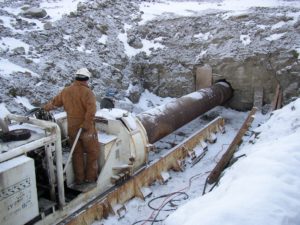
黄石俱乐部是位于蒙大拿州大天空的一个私人度假村,那里除了几英里的滑雪道外,还有一个18洞的冠军山高尔夫球场。用于灌溉高尔夫球场的管道长318英尺(96.9米),连接着附近一个蓄水量为7900万加仑的水库。
2005年,项目业主将该管道工程承包给了隧道系统公司(Tunnel Systems Inc.)。承包商一开始使用的是一种带有圣诞树形状的头部附件的螺旋钻孔机,但在挖掘到深度59英尺(4.9米)处,当他们开始在坚硬的岩石上钻孔时遇到了问题。接下来两天的钻孔工作仅推进了16英尺(4.9米)。 于是,隧道系统公司从罗宾斯公司租赁了一台直径30英寸(762毫米)的小型钻孔机(SBU) 来完成剩下的挖掘工作。
地质状况
隧道通过的坚硬岩石区存在混合地质,包括硬岩和岩土混合岩。
小型掘进设备
罗宾斯公司的小型掘进机是为了挖掘无侧限抗压强度超过24兆帕(3.5千磅力/平方英寸)的岩石的项目而量身设计的,这正是隧道系统公司选择该设备的原因。项目使用的是一款没有稳定支脚的小型掘进机,型号有直径30英寸(762毫米)和24英寸(914毫米)。稳定支脚是所有直径等于和大于36英寸(762毫米)的小型掘进机的标准配置,也适用于一些直径30英寸(762毫米)的掘进机型号。小型掘进机是基于大直径隧道掘进机的相同技术来设计的,为了获得最高效的硬岩掘进速度,该款小型掘进机还配备了具有罗宾斯公司专利的盘形滚刀。
隧道掘进
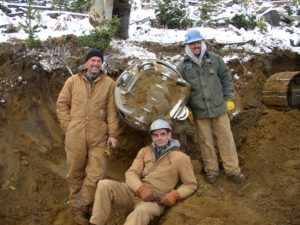
在施工现场,小型掘进机被焊接在主导管套管上,通过来自套管的推力和螺旋掘进机的扭转力进行掘进。产生的淤泥会在螺旋掘进机进中被运走。
自掘进以来,小型掘进机就取得了日掘进43-49英尺(13.1-14.9米)的骄人速度。螺旋掘进机和小型掘进机共打通了约196英尺(60米)的硬岩和隧道最后20英尺(6米)的混合岩及土壤。
尽管项目过程中遇到了一些阻碍,但项目最终按时竣工。现场气候条件严峻,19华氏摄氏度(零下7摄氏度)的低温和时速40英里/时(65千米/时)的大风让施工无法开展,挖掘工作也只能在暴风雪过后才能继续。施工队在暴风雪过后次日仅用几个小时就完成了该项目。
Tahoe Forest Hospital District Central Energy Plant Prep Project
Project Overview
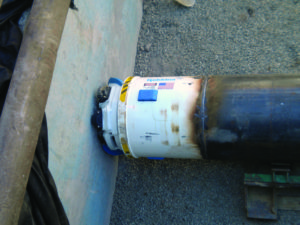 The Tahoe Forest Hospital is an expanding healthcare center located in Truckee, California. In autumn 2010, they were in the process of designing a new cancer wing when it was determined that additional utility and mechanical lines were required before the new building could be built. To house the bundled utilities, three crossings needed to be bored directly below the active main hospital.
The Tahoe Forest Hospital is an expanding healthcare center located in Truckee, California. In autumn 2010, they were in the process of designing a new cancer wing when it was determined that additional utility and mechanical lines were required before the new building could be built. To house the bundled utilities, three crossings needed to be bored directly below the active main hospital.
General contractor AM-X Construction & Excavation, Inc. subcontracted the three parallel 21 m (70 ft) sections to Silver State Boring Inc. Due to variable ground conditions and hospital noise constraints, the contractor opted for a Robbins SBU-A with a mixed ground head. This was the first time Silver State had used this type of cutterhead, but they were confident that it was the right machine for the job.
Geology
The hospital is set on ground containing large granite boulders, and Silver State was worried that one of these rocks would be hit during boring. This concern was actualized 7.6 m (25 ft) into the first bore when the SBU-A caught the edge of a boulder about 3.7 m (12 ft) in diameter. During the second bore, the machine drilled straight through the same boulder. Additional boulders of 175 MPa (25,000 psi) UCS were encountered during the third bore, and the SBU-A successfully powered through them as well.
What is a Mixed Ground SBU-A?
The Robbins SBU-A is a circular cutting head mounted with a combination of tungsten carbide bits, single disc cutters, and multi-row disc cutters. The SBU-A is available in diameters from 600 mm to 1.8 m (24 to 72 in), and can excavate a wide variety of hard rock and mixed ground conditions including dry soils, clay, cobbles and boulders from 25 to 175 MPa (4,000 to 25,000 psi) UCS.
During boring, the SBU-A is welded to an Auger Boring Machine (ABM), which provides both torque and thrust to the cutting head. Drag bits scrape soil from the machine face, while disc cutters excavate sections of rock. Muck scrapers scoop the excavated rock into large openings in the cutterhead, allowing for a smooth flow of muck from the face to the auger string.
Excavation
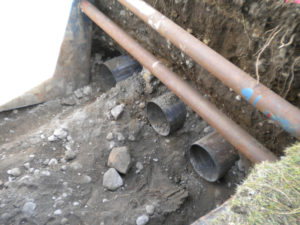 The SBU-A bored 2 m (8 ft) below the hospital’s foundation for the three jack-and-bore crossings. Straight bores were needed due to tight exit space, and each one began with a 609 mm (24 in) thick concrete starting block to keep the machine properly aligned. In addition, the older hospital has many buried utilities that needed to be cut and bypassed during site excavation. To make sure that everything would run smoothly, Robbins field service technicians visited the site prior to launch to assist with setup and crew training.
The SBU-A bored 2 m (8 ft) below the hospital’s foundation for the three jack-and-bore crossings. Straight bores were needed due to tight exit space, and each one began with a 609 mm (24 in) thick concrete starting block to keep the machine properly aligned. In addition, the older hospital has many buried utilities that needed to be cut and bypassed during site excavation. To make sure that everything would run smoothly, Robbins field service technicians visited the site prior to launch to assist with setup and crew training.
The first of the three bores began in October 2010, and by November 2010 all three bores were successfully completed. Advance rates for the duration of the project were approximately 3 m (10 ft) per day.
Due to the low torque and impact of the SBU-A, little stress was put on the ABM, no cutter changes were needed between bores, and the hospital was unaffected by noise or vibration during boring. Silver State was very pleased with the results, and used the technology again in 2011 for 609 mm (24 in) diameter bore in South Lake Tahoe, Nevada.
City of Clinton Contract B Force Main Project
Project Overview
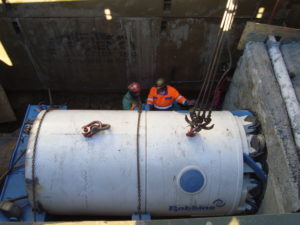 The Iowan towns of Clinton, Camanche and Low Moor have been identified as communities in desperate need of updated wastewater treatment systems. The towns all have over 10,000 residents, but their water and sewer treatment plants are inadequate and often over capacity. In 2009, a statewide recovery program called I-JOBS was created in Iowa, and USD $20 million in project funding was allocated to improving water quality. These funds were set aside for water treatment projects in the three towns.
The Iowan towns of Clinton, Camanche and Low Moor have been identified as communities in desperate need of updated wastewater treatment systems. The towns all have over 10,000 residents, but their water and sewer treatment plants are inadequate and often over capacity. In 2009, a statewide recovery program called I-JOBS was created in Iowa, and USD $20 million in project funding was allocated to improving water quality. These funds were set aside for water treatment projects in the three towns.
The City of Clinton awarded their portion of the funding, USD $9.5 million, to general contractor Merryman Excavation. Illinois-based L.J. Keefe Co. was chosen as the sub-contractor for the project. The contract, known as City of Clinton Contract B Force Main, called for six crossings below roadways and rivers, three of which required TBM tunneling. The remaining three crossings required SBUs. Two Robbins SBU-As were chosen for the 26.2 m (250 ft) and 82.3 m (270 ft) runs, and a third Robbins motorized SBU (SBU-M) was selected for the 120.4 m (395 ft) crossing.
Geology
The 26.2 m (250 ft) and 82.3 m (270 ft) crossings undercut the Mississippi river, and were identified as hard rock bores of over 70 MPa (10,000 psi) UCS in which SBU-As would be the best choice. The longest crossing was below traffic-heavy Highway 67, and testing of the area revealed a mixed face of sand, clay and 70 MPa (10,000 psi) UCS hard rock. Due to the variable ground conditions, the contractor opted for a 1.8 m (72 in) SBU-M, the largest of its kind yet built.
About the SBU-A
The Small Boring Unit (SBU-A) is a hard rock and mixed ground circular cutterhead which utilizes an Auger Boring Machine (ABM) and steel casing. During excavation, the SBU-A is welded to the lead casing while the ABM provides torque and forward thrust to the cutterhead.
The SBU-A is available in diameters ranging from 600 mm to 1.8 m (24 to 72 in), and its single disc cutters are capable of excavating rock from 25 to over 175 MPa (4,000 to over 25,000 psi) UCS. The cutters penetrate the rock face, creating a “crush zone” through which fractures occur. Material between adjacent crush zones falls from the face into muck buckets in the cutterhead. A full face auger is used to transfer the muck for removal.
About the SBU-M
The SBU-A’s cousin, the SBU-M, is a motorized SBU used for longer bores and line-and-grade critical crossings. In similar fashion to the SBU-A, the SBU-M is welded or bolted to the lead casing of an ABM. The machine is continuously steered by way of an operator’s console in the rear shield. A laser targeting system is used to monitor the machine’s heading. These features allow for increased accuracy and continuous monitoring, which was needed on the 120.4 m (395 ft) bore due to the mixed ground geology, strict line-and-grade requirements, and crossing length.
Excavation
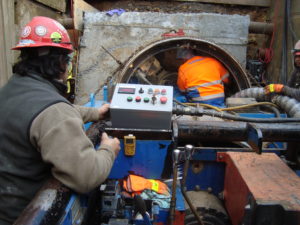 In November and December 2011, the 1.5 m (60 in) and 1.06 m (42 in) SBU-As, respectively, were launched 9.1 m to 10.6 m (30 to 35 ft) beneath a tributary of the Mississippi River. Each utilized an 18.3 m (60 in) ABM to excavate in the hard rock conditions. Both SBU-As broke through on time and within line-and-grade specifications. The first SBU reached completion on December 20, 2011, and its counterpart did the same on February 10, 2012. Each averaged advance rates of 6.1 m (20 ft) per day.
In November and December 2011, the 1.5 m (60 in) and 1.06 m (42 in) SBU-As, respectively, were launched 9.1 m to 10.6 m (30 to 35 ft) beneath a tributary of the Mississippi River. Each utilized an 18.3 m (60 in) ABM to excavate in the hard rock conditions. Both SBU-As broke through on time and within line-and-grade specifications. The first SBU reached completion on December 20, 2011, and its counterpart did the same on February 10, 2012. Each averaged advance rates of 6.1 m (20 ft) per day.
The 1.8 m (72 in) SBU-M was launched in January 2012 from a 7.6 m (25 ft) launch pit. Although the machine encountered an unexpectedly long drive of hard clay just 4.6 m (15 ft) into its bore, crews were able to keep moving by adding water through the cutterhead and the casing. This kept the muck coming through without contaminating the disc cutters.
Although challenging, advance rates of 6.2 m (20 ft) per day were maintained in the softer ground conditions. After about 70.1 m (230 ft) worth of clay, the machine hit solid rock for the remainder of the run. While in hard rock, rates increased to about 90.1 m (30 ft) per day.
On February 14, 2012, the SBU-M broke through into a receiving pit. It finished within line-and-grade requirements with very little deviation, even in the mixed face ground conditions during initial boring.
Shayler Run Segment C Sewer Replacement Project
Project Overview
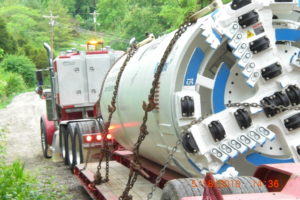 Seven new sewer tunnels were recently completed in Ohio’s Clermont County, replacing an outdated and exposed system that was dumping raw sewage into local Shayler Creek. Since 1978, when the previous pipeline was installed, the creek had eroded, exposing the pipe and putting certain sections of the line at high risk of failure. For all of these reasons, a new pipeline needed to be installed far below the environmentally-sensitive waterway.
Seven new sewer tunnels were recently completed in Ohio’s Clermont County, replacing an outdated and exposed system that was dumping raw sewage into local Shayler Creek. Since 1978, when the previous pipeline was installed, the creek had eroded, exposing the pipe and putting certain sections of the line at high risk of failure. For all of these reasons, a new pipeline needed to be installed far below the environmentally-sensitive waterway.
The Clermont County Water Resources Department hired Indianapolis contractor Midwest Mole for the $15M USD project, and chose to use only one machine for the seven tunnels. A 1.8 m (72 in) diameter Robbins Double Shield Rockhead was used to excavate all of the tunnels, totaling 2,900 m (9,513 ft). The contractor’s unique approach also included eliminating three shafts from the original bid, which shortened the project schedule and significantly lowered costs.
Ground Conditions
Because of the project location below the creek bed, ground conditions were highly varied, consisting of interbedded layers of limestone and shale that ranged from dry to sticky and wet. To accommodate the mixed ground, the machine was outfitted with a mixed ground cutterhead that could be swapped out for a hard rock cutterhead based on the ground conditions at each crossing.
The mixed ground cutterhead featured 6.5 in single disc cutters and carbide bits, while the hard rock cutterhead contained 11.5 in single cutters and abrasion-resistant muck scrapers. Both cutterheads had large openings which allowed for efficient cutter changes.
About the SBU-RHDS
The Robbins Double Shield Rockhead (SBU-RHDS) is a tunneling machine typically used on utility installations of over 150 m (500 ft). Its continuous steering capabilities and laser targeting system make it the ideal solution for line-and-grade critical installations such as the Shayler Run Segment C Sewer Replacement Project.
The SBU-RHDS is available in diameters from 1.4 to 2.0 m (54 to 78 in), and consists of a cutterhead optimized for mixed and hard rock ground conditions. The machine’s circular cutterhead contains disc cutters capable of excavating ground ranging from 25 to 175 MPa (4,000 to over 25,000 psi) UCS.
As the cutterhead rotates, the cutters penetrate the rock face creating “crush zones” through which fractures propagate. Material between adjacent crush zones is then chipped from the face. Muck scrapers scoop the muck into muck buckets, which transfer the muck onto a machine belt conveyor. Muck is transported offsite via conveyor belt or muck cars.
Excavation
 A total of seven tunnel crossings connected by eight shafts were constructed by Midwest Mole. The tunnels utilized the Rockhead, while the shafts were constructed using a combination of drill and blast techniques and manual excavation. A primary liner of ring beams and lagging was installed every 1.5 m (5 ft) at each crossing. Even with liner installation, high production rates of 12 to 18 m (40 to 60 ft) per 12-hour shift were maintained for the project duration.
A total of seven tunnel crossings connected by eight shafts were constructed by Midwest Mole. The tunnels utilized the Rockhead, while the shafts were constructed using a combination of drill and blast techniques and manual excavation. A primary liner of ring beams and lagging was installed every 1.5 m (5 ft) at each crossing. Even with liner installation, high production rates of 12 to 18 m (40 to 60 ft) per 12-hour shift were maintained for the project duration.
Due to the gravity sewer construction, each tunnel had strict line-and-grade requirements of within 300mm (1 ft) of line at 1 to 2% grade, which was continuously monitored from an in-shield operator’s console. Over the course of the project, the variance resulted in a vertical change of 53.9 m (177 ft) causing the machine to bore through a wide range of ground conditions.
Excavation of the initial 484.3 m (1,589 ft) crossing began in May 2010 in mixed ground, and the Rockhead broke through to its first shaft site that August. After a few minor modifications to the hydraulic and muck haulage systems, the machine began boring the second 575.4 m (1,888 ft) crossing.
Crossings 3 and 4, 321.9 m (1,056 ft) and 304.8 m (1,000 ft), respectively, were excavated in December 2010 and January 2011 in adverse winter weather conditions. In order to keep tunneling during freezing temperatures, the contractor heated the machine’s cooling water overnight. Cooling water was recycled and filtered, then stored in 7, 500 l (2,000 gal) tanks with heaters. Using this technique, production rates stayed high and both crossings were successfully excavated by January 2011.
The Rockhead began its fifth and longest crossing of 613.8 m (2,014 ft) in April 2011, and reached a world record in tunneling distance for a hard rock machine of its 1.8 m (72 in) diameter. For the last two crossings, 402.3 m (1,320 ft) and 196.9 m (646 ft), respectively, the mixed ground cutterhead was replaced with its hard rock counterpart.
Due to negotiations with local landowners and a change in shaft location, the final crossing began in January 2012. A month later, the drive was completed. In July 2012, the entire project reached completion right on schedule, with all manholes and ancillary sewers tied in and in service.
最近要闻
- Twin Robbins EPBs make milestones near Taj Mahal
- Long Haul TBM: Use of a Rebuilt Main Beam Machine at the DigIndy Tunnel System in Indianapolis, IN
- Evaluating TBM Design and Performance, 30 Years Apart: The Lesotho Highlands Water Tunnel, Phase 1 and Phase 2
- Overcoming Mountainous Geology at Nepal's Sunkoshi Marin Project
- Swift Robbins TBM breaks through 11 Months Early

 Close
Close  Menu
Menu 
